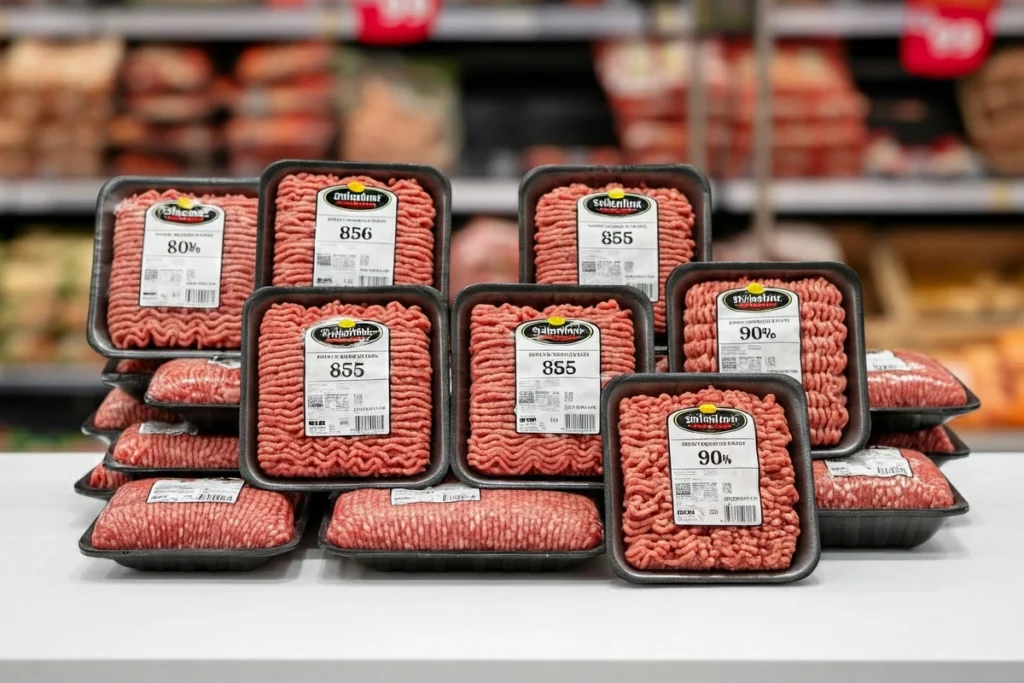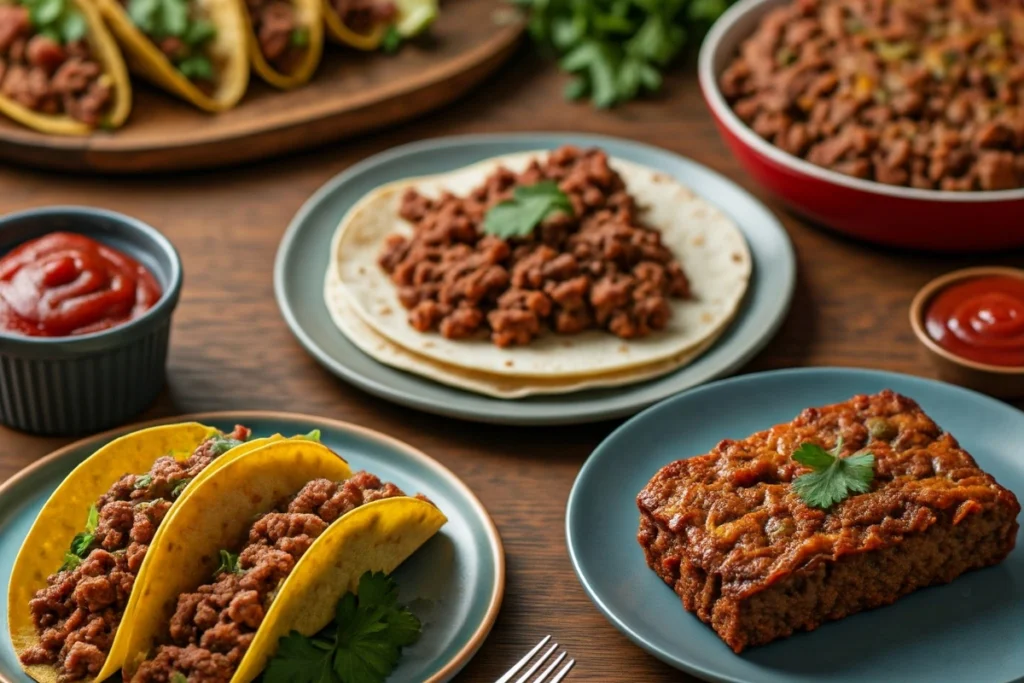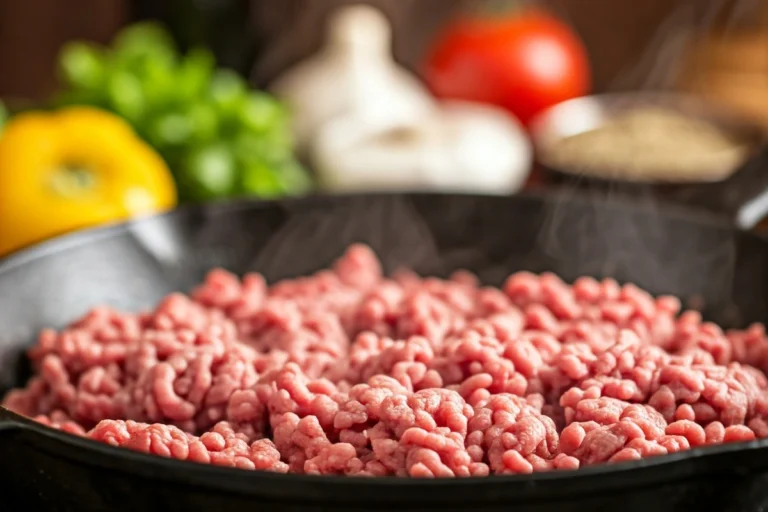Discover delicious ways to cook ground beef for everyday meals. Learn tips, recipes, and nutritional insights to elevate your culinary experience.
Why ground beef Is So Popular
Ground beef is a versatile option that fits effortlessly into many weeknight meals. Its affordability makes it accessible, while its hearty flavor satisfies even the pickiest eaters. Indeed, this staple can transform simple family dinners into memorable feasts. Moreover, its unique texture blends well with vegetables, grains, and sauces, resulting in dishes that are both comforting and nutritious.
Essentially, minced beef can be used in countless ways to create a wide array of cuisines. You can shape it into patties, form it into meatballs, or break it up for stir-fries and casseroles. Undoubtedly, its widespread availability makes it a favorite in supermarkets across the United States. Accordingly, home cooks keep returning to ground beef for its convenience and adaptability.
Furthermore, it is easy to store in the freezer for use at a later date. Simply transfer small portions into resealable plastic bags. Subsequently, you can defrost only what you need to minimize waste. Another significant benefit is the ability to cook it quickly. Chiefly, busy families enjoy how it can be browned in a matter of minutes for quick tacos or tossed into pasta sauces without hassle.
Selecting the Perfect ground beef for Your Kitchen
The term “ground beef” covers several different types based on fat content. Basically, the labels can read 80% lean, 85% lean, or 90% lean. Hence, the leaner the meat, the lower the fat content. However, a modest amount of fat can enhance flavor and prevent dryness. Therefore, striking a balance is key.
- 80% Lean (20% Fat): Ideal for dishes that require juicy consistency, such as burgers or meatloaf.
- 85% Lean (15% Fat): A versatile option that works well in sauces, casseroles, and stuffed peppers.
- 90% Lean (10% Fat): Perfect for health-conscious people wanting minimal fat. Nonetheless, it might need extra moisture, such as tomato sauce or broth.
Comparatively, many cooks prefer an 85% lean option. This category presents a hearty flavor while keeping extra grease at bay. Equally important, choosing locally sourced or organic ground beef can further enhance the quality of your meals. You may consider grass-fed varieties, which some believe offer a richer taste.
Meanwhile, always check for freshness by verifying the product’s color and expiration date. A bright red hue is typically best. Although a slight browning inside the package can be normal, any off-smelling odor is a sign that the meat might not be fresh. Finally, storing it in the fridge at or below 40°F is vital. This step ensures that any chance of spoilage is minimized.

Nutritional Highlights of ground beef
Ground beef provides essential nutrients like protein, iron, and vitamin B12. Particularly, it can support muscle growth and overall health. Moreover, lean ground options have fewer calories and saturated fats, which can be beneficial. For example, pairing lean ground meat with vegetables can create a wholesome meal without excess fat.
Nevertheless, moderation is key. Although ground beef can be part of a nutritious diet, balance it with fiber-rich sides like salads or whole grains. Especially, people with specific dietary concerns can choose leaner cuts. Always seek guidance from a nutrition professional if you have unique dietary needs.
Below is a quick snapshot of the average nutritional composition per 100g of cooked ground beef. The figures can vary based on fat content and cooking methods.
| Nutrient | Amount (Per 100g) |
|---|---|
| Calories | ~250 kcal |
| Protein | ~26 g |
| Total Fat | ~15 g |
| Saturated Fat | ~6 g |
| Carbohydrates | 0 g |
| Iron | ~2 mg |
| Vitamin B12 | ~2 µg |
These values are estimations and may change with cooking techniques. Draining excess fat from the pan will reduce total fat, whereas adding sauces can affect calorie content. Ultimately, mindful preparation is vital for keeping meals healthy while preserving taste.
Best Tools for Cooking ground beef
To prepare ground beef efficiently, it helps to have the right kitchen tools. Initially, a good-quality frying pan with a sturdy base is essential. This type of pan conducts heat evenly, preventing undercooked spots. In addition, a wooden spoon or spatula helps break the meat into small, consistent pieces.
Likewise, a meat thermometer ensures it is cooked to a safe internal temperature of 160°F. Particularly, this step reduces the risk of foodborne illnesses. Furthermore, a colander or strainer is useful for draining excess fat. Another handy tool is a slow cooker for making chili or hearty stews. With this method, you can set the machine and let the flavors meld together over several hours.
Ultimately, well-chosen tools shorten cooking time and improve food quality. Especially on busy days, streamlined cooking strategies reduce stress. By combining practical tools with fresh ingredients, you can create tasty dishes in less time.
Classic Meals Featuring ground beef
Many traditional recipes highlight ground beef. Indeed, Americans love comforting classics like meatloaf, burgers, and casseroles. Each dish offers a satisfying mix of protein and flavor. Moreover, they can often be adapted with healthy substitutions, like using whole-grain bread crumbs or extra vegetables.
Below, you will find several classic meal ideas:
- Hearty Chili: Combine ground beef, kidney beans, diced tomatoes, onions, and spices. Let it simmer slowly for robust flavor. Top with shredded cheese or a dollop of Greek yogurt.
- Juicy Burgers: Season the meat with salt, pepper, and garlic powder. Grill or pan-sear to lock in moisture. Add lettuce, tomato, and onion for added crunch.
- Traditional Meatloaf: Mix ground beef with breadcrumbs, eggs, diced onions, and seasonings. Shape into a loaf and bake until fully cooked. Slice and serve with mashed potatoes.
- Stuffed Bell Peppers: Hollow out bell peppers and fill them with seasoned ground beef, rice, tomato sauce, and herbs. Bake until the peppers become tender.
- Taco Night: Sauté ground beef with taco seasoning. Serve in tortillas or crunchy shells with lettuce, cheese, diced tomatoes, and salsa.
Additionally, these recipes adapt easily to personal tastes. If you enjoy spicy foods, add chili peppers or cayenne. Conversely, if you prefer milder flavors, focus on herbs like basil, oregano, or parsley. Basically, you have endless ways to incorporate ground beef into beloved classics.

Essential Steps for Preparing ground beef
Every delicious dish starts with proper preparation. Firstly, allow the meat to come to room temperature for about 15 minutes. This step helps it cook evenly. Next, season generously, but do so gradually to avoid over-salting. You can always add more seasoning later if necessary.
Secondly, heat a skillet before adding oil or cooking spray. Placing meat in a cold pan can lead to uneven browning. Thirdly, break up the beef with a wooden spoon or spatula, especially for dishes like tacos or casseroles. Afterward, drain the excess fat in a colander to manage grease levels.
Finally, verify that the internal temperature reaches 160°F. This detail ensures safe consumption. Altogether, following these fundamental steps leads to flavorful and safe-to-eat meals.
Healthier Twists with Lean ground beef
Opting for lean ground beef does not mean sacrificing taste. Equally, you can add more vegetables or whole grains to amplify both nutrition and flavor. For instance, you can incorporate finely chopped onions, bell peppers, or spinach. This approach increases vitamins, minerals, and dietary fiber while providing an appealing texture.
Comparatively, you can also swap out refined carbs for whole grains. For example, use whole-wheat pasta or brown rice to pair with your lean beef sauce. This decision boosts your meal’s fiber content and contributes to better digestion. Additionally, focus on herbs and spices like cumin, paprika, or rosemary for depth instead of relying on salt.
In particular, homemade sauces let you control sodium and sugar levels. If you crave a creamy texture, blend cottage cheese or low-fat Greek yogurt for a healthy spin. Another beneficial option is to use vegetable-based sauces, such as those made from roasted tomatoes or red peppers.
Ultimately, small adjustments can significantly enhance your dish’s nutritional profile. Your body will appreciate the vitamins, minerals, and antioxidants found in fresh ingredients. Especially when combined with lean ground beef, these nutritional perks create a balanced, health-forward meal.
For other healthy recipes, check our article about “Are Tater Tots Healthy?”
Ten Savory Dishes Using ground beef
Variety is essential to keep mealtime exciting. Therefore, here are ten savory ideas to expand your ground beef repertoire. Each dish highlights a unique cooking style, ensuring there is something for everyone. Moreover, these recipes span a range of difficulty levels, from beginner-friendly to more advanced.
- Bolognese Sauce
- Simmer ground beef with tomato sauce, onions, carrots, and celery.
- Serve it over al dente pasta or spiralized zucchini noodles.
- Beef and Broccoli Stir-Fry
- Sauté ground beef with garlic, ginger, soy sauce, and chopped broccoli.
- Toss everything with a cornstarch slurry to thicken.
- Swedish Meatballs
- Combine seasoned ground beef with breadcrumbs and eggs.
- Cook in a skillet, then serve with a creamy sauce over noodles.
- Sloppy Joes
- Sauté ground beef and onions in a tangy tomato-based sauce.
- Spoon onto soft burger buns and enjoy the messy fun.
- Beef Zucchini Boats
- Hollow out zucchinis and fill with spiced ground beef and cheese.
- Bake until everything turns bubbly and golden.
- Shepherd’s Pie
- Layer ground beef with vegetables under a blanket of mashed potatoes.
- Bake until the top browns and the filling is bubbly.
- Enchiladas
- Wrap seasoned ground beef in tortillas and cover them in red or green sauce.
- Top with shredded cheese and bake until melted.
- Moussaka
- Brown ground beef with onions and spices.
- Layer with eggplant slices and top with béchamel sauce.
- Beef Empanadas
- Fold spicy ground beef filling into small dough pockets.
- Bake or fry until golden and crispy.
- Stuffed Cabbage Rolls
- Roll ground beef and rice into softened cabbage leaves.
- Simmer in a tomato-based sauce for an enriching meal.
Each of these dishes can be customized with various seasonings, side dishes, and garnishes. Subsequently, you can experiment with herbs, spices, and sauces to create your personal twist.
Budget-Friendly Tips for Buying and Storing
Food costs can add up fast, particularly for large families. Nevertheless, ground beef can be an economical option if you shop wisely. First, consider buying in bulk. Many stores offer discounts on larger packages. Divide it into portions and store each bundle in freezer-safe bags. Label them with the purchase date to track freshness.
Furthermore, look for sales or discounts on ground meats nearing their sell-by dates. If you plan to cook them immediately or freeze them, you can save money. Another simple trick is to combine the beef with cost-effective fillers like beans, lentils, or chopped vegetables. Thus, your dish stretches further without sacrificing taste.
When storing, freeze your meat promptly if you don’t plan to cook it within a day or two. Wrap it tightly to prevent freezer burn. Generally, it remains safe to consume for up to three months when frozen properly. Eventually, thaw it in the refrigerator or use the defrost setting on your microwave for quick meal prep.
Building Global Flavors with Minced Beef
Minced beef is a cornerstone in countless international cuisines. Accordingly, each culture adds its distinct blend of spices, herbs, and sauces. You can discover new taste sensations by exploring diverse regions:
- Italian Cuisine: Use ground beef in lasagna, cannelloni, and pasta sauces.
- Greek Cuisine: Incorporate it into moussaka or keftedes (meatballs) with oregano and garlic.
- Mexican Cuisine: Elevate tacos, enchiladas, or picadillo with cumin, chili powder, and tomatoes.
- Asian Cuisine: Prepare stir-fries, dumplings, and spring rolls by combining minced beef with soy sauce, ginger, and vegetables.
Undoubtedly, traveling the world through your dinner plate keeps cooking exciting. Chiefly, it demonstrates how one simple ingredient can take on many guises. Each approach delivers unique aromas, textures, and flavor profiles that keep your meals fresh and interesting.
Beyond Dinner: Breakfast and Lunch Possibilities
It may seem unconventional, but ground beef can also enhance breakfast and lunch. For instance, you can prepare a breakfast hash by sautéing leftover ground meat with potatoes, onions, and peppers. Top with a fried egg, and you have a protein-packed morning treat.
Meanwhile, for lunch, homemade beef patties served in a lettuce wrap can keep you energized. Add sliced avocado or tomato for extra vitamins and healthy fats. Another lunchtime favorite is a leftover chili bowl. Simply reheat last night’s ground beef chili and enjoy. You can even toss some into a salad for a heartier midday meal.
Because this protein is so adaptable, you can incorporate it into various recipes without getting bored. Altogether, it supplies consistent taste and dependable nutrition any time of day.
Cooking Methods and Temperature Tips
Cooking methods can greatly influence the taste and texture of your meals. Grilling is a popular choice for making burgers. It imparts a smoky flavor that many find irresistible. Conversely, pan-searing in a cast-iron skillet creates a delicious crust. If you prefer a slow-cooked approach, a crockpot can transform tough cuts into tender meals.
Ensure you always monitor the internal temperature of ground beef. Using a meat thermometer is crucial, especially when forming patties. Ground meats need to reach an internal temperature of 160°F to kill harmful bacteria. Because each stove and oven vary, checking with a reliable thermometer prevents guesswork.
Therefore, do not rely solely on the color of the meat to gauge doneness. Sometimes, ground meats can still appear pink even when fully cooked. Equally, if you see clear or faintly tinted juices, that is often a good sign that the beef is safe to eat. Finally, resting the meat for a few minutes after cooking can help redistribute its juices for maximum succulence.
How to Reduce Fat and Calories
If you are looking to reduce fat in your meals, you have several choices. Chiefly, start by purchasing lean cuts of ground beef with lower fat content. In addition, always drain the meat after browning. This step drastically lowers the amount of grease.
Subsequently, add vegetables like mushrooms, onions, and peppers to the dish. These vegetables contribute moisture, meaning you rely less on oil or fats for flavor. Furthermore, using herbs and spices is another excellent strategy. For instance, fresh basil, thyme, or parsley can elevate your dish without adding unwanted calories.
Comparatively, you can reduce cheese toppings or replace them with lighter alternatives. Instead of sour cream, consider low-fat Greek yogurt for a tangy punch. Because small shifts in ingredient choices add up, you can continue enjoying ground beef while keeping calories in check.
Simple Meal Planning with Ground Beef
Weekly meal planning simplifies shopping and cooking. Basically, choose a theme for each day, such as Taco Tuesday or Chili Wednesday. By doing so, you can ensure you have ground beef on hand and portioned correctly.
Additionally, create a grocery list around these themes to avoid impulse buys. For example, if you plan to make burgers, include buns, lettuce, and tomatoes on your list. Conversely, if you opt for soup or stew, pick up celery, carrots, and stock. Planning ensures you have all ingredients at your fingertips, reducing the risk of takeout.
Altogether, meal planning helps save time, money, and stress. Meanwhile, you can achieve a more balanced diet by spreading out different types of proteins and vegetables throughout the week. Eventually, you will notice that your cooking routine becomes more organized and enjoyable.
Conclusion
Ground beef is a staple ingredient in countless U.S. kitchens. It adapts to a broad range of recipes and provides essential nutrients. By choosing the right cut, storing it properly, and cooking it with care, you can enjoy a variety of delicious dishes.
Consider experimenting with international flavors and healthier twists to keep mealtime fun. Add more vegetables, lean cuts, and vibrant spices to make your meals both nourishing and tasty. Whether you are planning a comforting dinner at home or a quick lunch on the go, ground beef has a reliable spot on your menu.
Frequently Asked Questions (FAQs)
How many calories in a pound of ground beef?
A pound of ground beef (approximately 454g) contains about 1,100 to 1,200 calories. The exact amount varies based on fat content and cooking methods.
How much protein in ground beef?
A 100g portion generally contains around 26g of protein. This figure changes slightly depending on the lean-to-fat ratio.
How much protein in a pound of ground beef?
A pound of ground beef typically provides between 100g and 115g of protein. The exact amount depends on cooking and the initial fat percentage.
How many calories is 8oz of ground beef?
An 8oz serving (about 227g) has roughly 550 to 600 calories, depending on fat content and cooking style.

